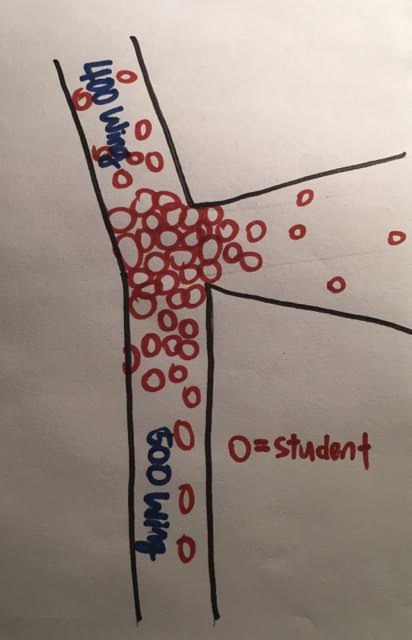400-500 Wing Intersection Causes Physical and Psychological Harm
December 20, 2015
The latest casualties of poorly planned architecture include 3 wounded, 72 nauseous, and 572 late to class due to heavy volume in the 400-500 wing intersection. As two wings (three, including the atrium) collide into one another, students can hear sounds of frantic cries akin to humpback whales vocalizing in pain and confusion.
The physical tumult is no easy obstacle, as Sikata Sengupta ‘18 explains: “I get pushed all the time.” Such shouts and aggression are difficult to deal with for distressed students who end up crossing the threshold two, maybe three times a day. Such traffic jams also result in the terror of being late to class, as teachers berate late students. A mad dash to the classroom, in turn, only creates more shoving and pushing. The tragedy of clogged hallways and smushing into strangers only detracts from the high school experience.
If one were to delve into the history of Ridge High School, one would find that the building was originally only suitable for 492 students. Additions in 1966 and 1999 added wings askew to the school, creating the jagged, odious intersection of the 400 and 500 wings. The fire safety department now believes RHS is suitable for the 1,811 students in our school body.
We, as Ridge High School students, must not stand for the crimes committed by school architects. Currently, Ridge High School only merits 4.2 stars on Google. How much of the 0.8 stars lost is due to heavy traffic flow and the aggression of hallway travels?
Bhavik Shah, ‘17, answers the burning question, stating, “I don’t think it really affects the ratings much.”
But our status is clearly being affected. We must preserve Ridge High School’s influence as “a national society in miniature” (as determined by our History webpage) and rid ourselves of this most dangerous intersection!
The traffic must immediately be worked around or demolished. Bhavik Shah ’17 once again offers words of wisdom with a suggestion: “You could improve the traffic by forcing people to walk in a traffic circle-like pattern—although that would look kind of weird.” The highly effective, apparently strange, technique of avoidance could definitely be used to herd aimless, sheep-eyed students to their classes.
Alternatively, Sikata Sengupta ‘18 suggests that Ridge could “control the flow of traffic at that region a bit more, or perhaps create a new hallway/staircase.”
Traffic management is a must and a new hallway would alleviate the burdens of the intersection as the fastest route. Clearly, the architects did not tap into student potential here at Ridge High.

